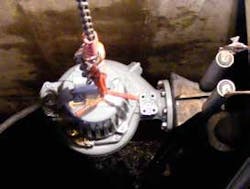The scenic community of Waupaca, Wisconsin derived its name from the translation of a Native American term meaning “clear water”. It seems doubly ironic that community wastewater passes through a facility known as the “Crystal River” Lift Station, once notorious for its three pumps becoming clogged with filthy debris since their installation in October 2002.
Project Background
The 360-GPM Crystal River Lift Station ranks among the largest of Waupaca’s 12 sewage pumping stations. It serves more than 10,000 residents and its wastewater flows to a 1.5 MGD regional treatment plant operated by Waupaca’s utility. After undergoing treatment, the effluent, restored to standards, discharges into the Waupaca River. It was not uncommon for the Crystal River Lift Station’s wetwell to accumulate a thick mat of fibrous waste. “We experienced clogs once and sometimes as often as three times per day,” remembers Jeff Dyer, wastewater team leader.
“The old pumps cavitated badly and weren’t reliable. They simply weren’t engineered to operate efficiently in that environment and they eventually faced replacement.”
The frequent clogs forced Waupaca’s Public Works Department to be dispatched on a 24-7 basis. The pump blockages presented an inherently unhealthy environment complicated even more by occasional seasonal weather challenges at the site. Also, if proactive monthly cleanouts exceeded the capability of the city, an outside contractor was called in.
Solution
When the aging former pumps eventually needed either a major overhaul or replacement, the Wastewater Department favored the latter. Several types of pumps were under consideration when a territory manager for Xylem, the manufacturer of Flygt brand pumps, responded to the utility’s inquiry.
The discussion about the recurring clogging eventually focused on a Flygt N-pump as a promising solution. The award-winning pump was specifically designed to handle the growing challenges of today’s higher debris laden wastewater flows.
The Flygt N-pump’s improved efficiency derives largely from a self-cleaning, semi-open, back-swept impeller. The horizontally positioned vane delivers superior hydraulic efficiency that also can contribute energy savings by eliminating the drag imposed on many earlier pumps with debris building up on their recessed impellers.
The N-pump’s hydraulic design eases the passage of solids while self-cleaning the edges on the unit’s impeller with each revolution. By eliminating ragging, the N-pump prevents the steady build-up of fibrous material that can otherwise impose drag and compromise respective energy usage and operating efficiency.
“The reliability of the replacement pumps has been excellent…and the other concerns we had about repeated emergency call outs day and night during all types of weather are no longer a factor.”
Result
The installation made use of the existing rail-type mounting system of the existing pumps. The swap quickly met expectations by performing flawlessly during the trial. In fact, the trial pump was set to operate in permanent lead pump mode instead of the normal one-third operating sequence.
Since the trial pump was always operating, the trial period essentially subjected the pump to a continuous 180-day operating test. During the test, the companion existing pumps continued to clog during the duration of the trial. This led the utility to procure a second Flygt N-pump in 2009 and the replacement of the third pump in 2012, Dyer said. The three 10-HP N-3127 pumps run in continuous sequence with run times averaging 1.4 hours each during 11 cycles on a typical day.
Editor's Note: Scranton Gillette Communications and the SGC Water Group are not liable for the accuracy, efficacy and validity of the claims made in this piece. The views expressed in this content do not reflect the position of the editorial teams of Water & Wastes Digest, Water Quality Products and Storm Water Solutions.

